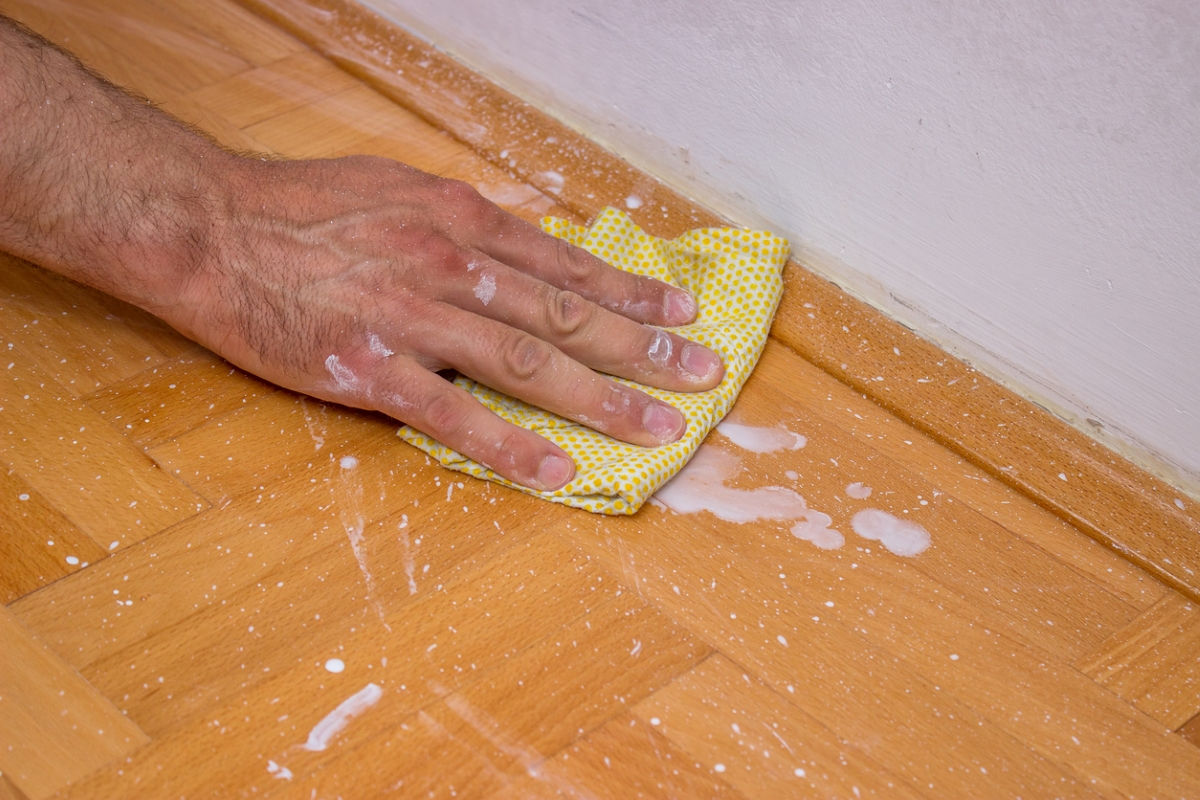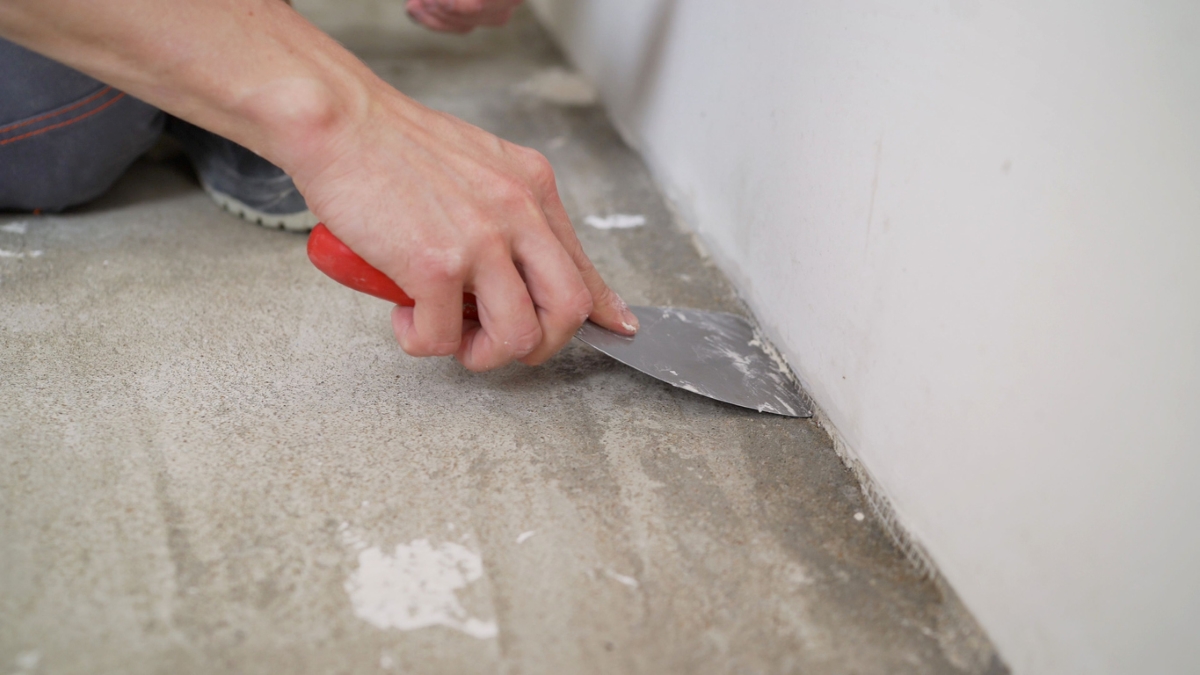We may earn revenue from the products available on this page and participate in affiliate programs. Learn More ›
Revamping a room can be as easy as applying a fresh coat of paint to the walls, but the unfortunate by-products of painting projects are spills and splatters. Even the most careful painters can find their efforts marred by drips on the countertop, linoleum, or carpeting.
Fortunately, most paint splotches can be cleaned up with a few handy household cleansers and tools—microfiber cloths, rubbing alcohol, nail polish remover, and sometimes just plain water—along with a bit of elbow grease. Learn our secrets to how to remove paint from a variety of surfaces.
How to Remove Paint From Glass

Removing paint splatters on glass without scratching the surface takes the right tools and a little patience. Dish soap and a safety razor blade can remove fresh or old, dried-on paint. Mix dish soap with warm water until sudsy, and thoroughly wet the window with a sponge or cloth. Hold the razor blade at a 45-degree angle, and carefully scrape the paint away, keeping the glass damp to avoid scratches.
RELATED: The 13 Painting Mistakes Almost Everyone Makes
How to Remove Paint From Countertops

It can be tough to remove paint from countertops without causing damage, so proceed cautiously. Apply a thin coat of olive oil to the paint drips and rub with a dry cloth, working in a circular motion. For stubborn spots, wrap a cloth around a plastic putty knife, then scrape, exerting light pressure. As a last resort, try applying a small amount of mineral spirits and wiping with a dry cloth.
RELATED: 10 Things You Should Never Paint
How to Remove Paint From Carpet

It is easiest to remove paint from carpet before it dries, using dry paper towels or old terry cloths to blot—not rub—the spill. A bit of glycerin on the towels may help loosen the paint. For stubborn spills, try blotting with white vinegar or nail polish remover. Old paint drips may need a commercial cleaning agent, such as WD-40 or Goof Off. Remember: When using any new cleaning agent, always do a spot test in an inconspicuous area first.
RELATED: How To: Get Rid of Every Carpet Stain
How to Remove Paint From Floors

Removing paint spills from linoleum or vinyl floors without damaging the surface can be tricky. Start by applying dish soap and warm water, blotting up as much of the spill as possible. Remove stuck-on residue using a plastic scraper. Tough spills may require a solvent like rubbing alcohol or mineral spirits, but apply these cautiously because excessive use can dull the floor’s finish. For stubborn drips, very gently rub away the spots using liquid floor wax or a wood cleaner like Scott’s Liquid Gold and superfine steel wool.
RELATED: How to Clean Vinyl Plank Flooring
How to Remove Paint From Wood

Denatured alcohol, a clean cloth, and a lot of patience can remove latex paint from wood without damaging it. Oil-based paint splatters require mineral spirits, but the trick is not to soak the wood—too much mineral spirits can damage the wood’s finish. Wipe it up thoroughly with clean water and let it dry once the paint is removed. If the wood does become discolored, try touching it up with a wood finish repair pen like Minwax’s Wood Finish Stain Marker.
RELATED: What’s the Difference? Mineral Spirits vs Paint Thinner
How to Remove Paint From Concrete

Paint spills on a concrete floor can be vanquished using commercial cleaners. First, use a stiff brush and a paint scraper to loosen the paint, then vacuum up all debris. Next, apply a paint stripper; these typically take anywhere from 60 minutes to 8 hours to work. Repeat the process as needed according to the product’s instructions. Finish the job by using a pressure washer to remove all traces of the paint stripper.
RELATED: Cement vs. Concrete: What’s the Difference?
How to Remove Paint From Brick

It can be a challenge to remove paint from brick without causing damage. Usually the best bet is to use fabric strips and a paint-removing gel or paste like the biodegradable Dumond Chemicals Smart Strip Advanced Paint Remover. Saturate a soft fabric with the gel, then place it over the brick. Allow the product to stand as long as the manufacturer recommends, then when you peel off the fabric the paint should also peel away. Clean remaining residue with a stiff nylon-bristle brush.
RELATED: How to Clean Brick, Indoors and Out
How to Remove Paint From Plastic

Many commercial paint removers can actually melt plastic. A better course of action is to use vegetable oil to soften the paint, and gently scrape away paint drips with a plastic putty knife.. For tougher spots, try nail polish remover or denatured alcohol, but first test a small patch to make sure the solvent does not damage the plastic. Clean off all traces of the solvent with dish soap and warm water.
RELATED: The Best Paints for Plastic
How to Remove Paint From Clothes

First, carefully scoop off any wet paint off the fabric with a knife or spoon. If the paint has dried on the fabric, scrape off any dried paint with a plastic knife or stiff brush. Run warm water on the backside of the fabric and blot the front with a clean cloth.
Next, make a 50-50 mix of detergent and warm water, then blot the fabric with a clean cloth. Apply stain remover if the fabric’s care label indicates that it’s safe, then launder the clothing as you usually would.
RELATED: How to Get Caulk Out of Clothes: 3 Effective Methods
How to Remove Paint From Shoes

To remove paint from leather shoes, dip a damp microfiber cloth in white vinegar, then wipe the material around the paint using circular motions. Let the vinegar sit for a few minutes before wiping it away with a fresh, damp cloth. If paint remains, you can try adding some rubbing alcohol or turpentine. Just make sure to apply a leather conditioner when you’re finished to rehydrate your shoes.
For paint on canvas shoes, soak the shoes in warm water for a few minutes to loosen some of the paint. Use a toothbrush to apply a few drops of dishwashing detergent and water, scrubbing the affected areas until the paint is gone. If stains persist, try rubbing alcohol or turpentine.
RELATED: How to Wash Shoes in a Washing Machine
How to Remove Paint From a Paint Can Lid

While it’s best to always wipe the rim of a can of paint clean before putting the lid back on, it doesn’t always happen. Any paint left in the rim’s ridges can dry and fuse the lid to the can. If the lid is stuck, try using needle nose pliers to pinch it and peel it up around the rim. Slowly work your way around the rim until the lid separates from the can. You may need to use a utility knife to score any gummed-up paint.
Before replacing the lid, use the utility knife and multitool to remove the dried paint on the rim. When most of the paint is gone, use a multipurpose cleaner and cloth or an old toothbrush to scrub remaining dried paint bits before they fall into the can.
RELATED: How to Open a Paint Can the Right Way
How to Remove Paint From Tile

For tile that’s durable and porous, you can use a razor blade or utility knife to gently scrape paint away. Use a damp clean cloth to moisten the area and help remove the paint flakes. For fragile tiles, a 50-50 solution of white vinegar and water can help remove the paint. Moisten a soft cloth with the solution, then lay the cloth on the paint-splattered area for a few minutes. Scrape the paint off with the knife blade.
RELATED: Porcelain or Ceramic: Which Tile Type Is Right for You?
How to Remove Paint From Hardwood Floors

First, determine whether you’re removing water-based or oil-based paint. It matters! If you’re not sure, test a small spot by dipping a cotton ball into isopropyl alcohol, aka rubbing alcohol, and wipe it over a small paint spot. If there’s paint on the cotton ball, then you’re working with water-based or latex paint. If not, you have oil-based paint, which is trickier to remove.
To remove water-based paint, apply a few drops of dishwashing soap in 2 cups of water, then use a microfiber cloth to apply it to the paint. If stubborn stains remain, you can mix 3 parts rubbing alcohol with 1 part lemon juice, then apply it to the floor with a microfiber cloth.
For oil-based paint, you’ll need paint thinner, such as turpentine. Making sure you ventilate the room well—open windows, and run a fan— apply the paint thinner per the product’s instructions. Ise a microfiber cloth to rub at the paint until it’s gone.
RELATED: The Best Way to Clean Hardwood Floors
How to Remove Paint From Leather

Dip a damp microfiber cloth in white vinegar—make sure it’s white vinegar and not another type—then gently wipe the cloth around the paint using circular motions. Let the vinegar solution sit on the affected area for a few minutes before wiping it away with a clean, damp cloth. Continue this process until all paint is removed. When you’re done, the leather might feel dry; apply a leather conditioner to rehydrate it.
RELATED: How to Clean Leather Furniture
How to Remove Paint From Metal

For small metal items, start by mixing a solution of 1/4 cup baking soda or vinegar and 1 quart of water. Bring the solution to a boil in a large pot, then add the stained metal pieces, boiling them for 15 minutes. Remove the items, place them on a heat-safe surface, and scrape off any remaining paint with a paint scraper.
If you need to remove paint from large metal areas or you have latex paint that’s tough to remove, use ammonia or acetone. Working in a well-ventilated area, dab a microfiber cloth into ammonia or acetone, then rub in a circular motion to gently remove the paint. If the paint stains are particularly stubborn, you can let the solution sit on the metal for a minute or two, then rinse with clean water.
RELATED: Solved! What’s the Best Paint for Metal Surfaces?
How to Remove Paint From Walls

Your best bet to remove interior paint is to mix a few drops of dishwashing soap in 2 cups of water, then dip a microfiber cloth into the solution and rub it on the walls, using gentle circular motions. Repeat the process until the paint is removed. You can also do this with 1 part white vinegar and 1 part water. If any paint remains or you’re dealing with oil-based paint, you may need to use a paint thinner, like turpentine, instead.
RELATED: How to Thin Latex Paint
How to Remove Paint From Cars

It’s not advisable to remove paint from your car’s exterior since you can damage the finish. That job is better left to the pros. But if you spilled paint inside your car, you can tackle it in much the same way you’d handle removing paint from shoes.
To clean the interior, dip a damp microfiber cloth in white vinegar then wipe the affected area using circular motions. Let the solution sit for a few minutes before rubbing it off. If any paint remains, you can dip the cloth in rubbing alcohol and repeat the process until the paint is gone.


